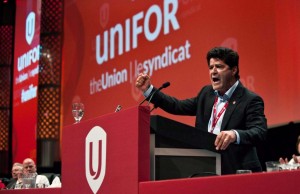
Unifor Pres. Jerry Dias comes from the communications side of the new union - with no experience in the automotive world.
This story has been updated to reflect the prior automotive experience of new Unifor Pres. Dias.
The Canadian Auto Workers Union is gone, having completed a merger with the Communications, Energy and Paperworkers Union of Canada to create a new union that will go by the name Unifor.
As part of the merger, CAW national president Ken Lewenza, a veteran of negotiations with Detroit’s automakers, and CEP president Dave Coles opted to step aside for new leadership team. Unifor’s new president, Jerry Dias, who was installed during a convention in Toronto,was one of Lewenza’s administrative assistant at the CAW, and has participated in negotiations with Detroit’s automakers.
He’ll have to face off with automakers who have increasingly complained about rising labor costs in Canada – and who have been threatening to transfer work and jobs back to the U.S. or even Mexico.
Dias, however, said during his acceptance speech that organizing will be one of the new union’s top priorities. The old CAW had organizing efforts in place for several months at plants in Ontario operated by Toyota and Honda. The new union boss said he would uphold Unifor’s promise to dedicate 10% of its revenues to organizing workplaces and adding new members.
In the wake of the convention, Unifor becomes Canada’s largest private sector union and has more than 300,000 members spread across more than 20 different segments of the Canadian economy. Union membership is relatively common in Canada where about 25% of workers belong to organized labor groups.
Outgoing CAW President Lewenza said he is most proud of how the CAW, which emerged from a divisive split with the United Auto Workers during the mid-1980s, has been an advocate for the rights of workers and has pressed hard to improve the lives of its members and communities. Those are priorities that Unifor will maintain, he said.
“Why is it that our young generation can’t have the same opportunities as us?” Lewenza asked union representatives gathered at the convention.
Lewenza pointed to a recent Canadian Labour Congress report that found that unionized workers in Canada make an average of $5 an hour more than their non-unionized neighbors. Unions should be talking about that, and be proud of what they have done to improve the lives of their members and urging more people to join, Lewenza said, especially young people.
“When I was 18, I won the lottery,” Lewenza said, retelling the story of how he followed his father’s advice and got a job at the Chrysler plant in Windsor.
That switch in 1972 took him from minimum wage of $1.65 an hour to a union wage of $4.65, plus a pension, benefits, time off, a seniority list and more. Everyone, he said, deserves that kind of opportunity.
Dias said he hopes to use his new position as president of the newly consolidated union to turn the tide for Canada’s labor movement. “Unifor is here because it’s time to stop playing defense and it’s time we started to play offense,” he declared. “It’s time to stop reacting and it’s time to start setting the agenda.”
(Labor problems mount for Kia and Hyundai. For more, Click Here.)
The new Unifor president had particularly harsh words for Canada’s Conservative government which he accused of “singling out unions,” and weakening the ability of labor groups to collect dues and organize.
“This is about challenging the status quo and making sure the governments have a formidable foe if in fact they decide to take on the trade union movement.”
(Click Here to read about Austrailian workers offering concessions to GM to keep factories open.)
He also said that Unifor would welcome workers traditionally excluded from collective bargaining and would seek other ambitious and creative ways to expand membership. A major part of this strategy, according to Dias, will aim to harness discontent among unemployed youth.
“Young people today are crying for a union,” said Dias, who pointed to the Quebec student protests and the occupy movement as examples of frustrated youth. “Young people have had it, they see that society is leaving them behind and they are not going to take it.”

You can bet no corporate execs are taking pay or benefit cuts but they took a pound of flesh from laborers during the recent economic crisis that continues for most of the middle class. The Execs will just transfer as many jobs as they can to Mexico or China. This will result in even bigger annual multi-million dollar bonuses for the execs.